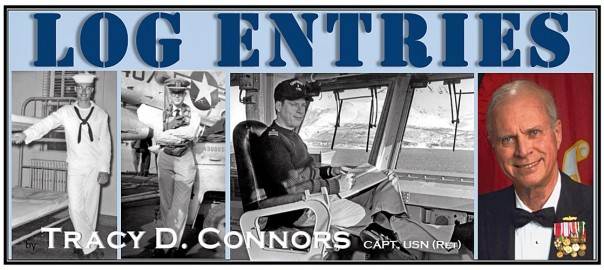Many hopeful JO’s stood watches as the Junior Officer of the Deck for months, and never received the coveted letter of qualification. Those who did had been aboard the ship for several years and had been promoted to Lieutenant Junior Grade from their starting rank of Ensign.

In April, 1963 I earned my letter of OOD u/w qualification while still an Ensign. I was shocked when Captain Walter Clarke signed it one beautiful spring day while we were steaming back to CONUS from over nine months of deployment in the Mediterranean. Since we were in the middle of a beard growing contest (to help liven the boring two week transit of the Atlantic) I scratched my blond, itchy stubble in wonderment.
I was shocked, then ecstatic. Here I was still an Ensign, and I was one of only seven or eight JOs on the ship with a qualification letter. My place in the Wardroom was secure. I don’t remember if I swaggered, but I must have.
The Captain told me that I was the most junior officer he had ever qualified as an OOD underway. Of course, I took the honor, and it was mostly that, very seriously. In fact, when I had the “deck and the conn” it was the most totally focused, single-minded thing I ever did. I took great pride in training my watch team, running them through innumerable drills, preparing us for the time when a plane in the water, or a man overboard would not be a drill but the real thing. We dreaded the thought, but we knew the day would come.
Following an all too brief period at home and in the Brookland Naval Shipyard for repairs, some months later we were again transiting the Atlantic—in the opposite direction. We planned our passage through the Straits of Gibraltar to ensure that we went through at high speed at midnight. The new CO, Captain Gerry Miller had asked that I be assigned the Mid Watch. I would take us through the straits and into the Med.
It was standard procedure for us to relieve the watch starting 15 minutes prior to the hour. It was also SOP for the watch team to go through the Combat Information Center for a briefing on the surface picture prior to the watch. This time, I was the CIC Watch Officer for the watch preceding.
In the hours prior to my bridge watch, I had watched the blips on my radar repeater grow in density as we neared the straits. Ships from all over the world were feeding into this “choke point,” coming and going through the narrow passage at speeds ranging from a few knots to an average of 12 to 15 knots.
As was standard practice dictated, we were doing 25 knots. Not only were we overtaking the ships steaming east into the Med, but our closure rate on those ships steaming west out of the Med was between 30 and 45 knots. It was no time for a mistake. Large ships do not maneuver easily. Aircraft carriers are even worse.
At 15 knots when I ordered the “helm” over 15 degrees to start a turn, it would take nearly half a minute for the compass to click over just one degree. “Ship drivers” had to think and act way ahead of where they were.
Continued on Page 3 below…
© Copyright 2018 BelleAire Press
Other works by Dr. Connors…
Baited Trap, the Ambush of Mission 1890
Now Available As E-Pub

Baited Trap, The Ambush of Mission 1890 is the story of helicopter rescue Mission 1890, one of the most heroic—and costly—air rescues of the Korean War. This harrowing Air Force-Navy mission is explained in compelling detail, creating a detailed personal account of what five incredibly brave and determined Air Force and Navy airmen achieved on June 25, 1952 in the infamous “Iron Triangle.”
The Korean War’s Greatest Love Story
Baited Trap is much more than a heroic war story from the “forgotten war.” It is also the Korean War’s greatest love story, following Wayne and Della Lear, Bobby Holloway, Ron Eaton and Dolly Sharp, and Frankie and Archie Connors as they tried to put their lives and families together even as the Korean War was reaching out to engulf them.
Truckbusters From Dogpatch: the Combat Diary of the 18th Fighter-Bomber Wing in the Korean War, 1950-1953

Truckbusters from Dogpatch is the most comprehensive Korean War unit history yet prepared–over 700 pages summarizing squadron histories and first person accounts—and includes over 1,000 never before published photographs and images, highlighted by the 8 ½ x 11-inch format.
Arguably, Truckbusters From Dogpatch is the most authoritative unit history ever prepared on the Korean War. In addition to consulting formerly classified squadron histories filed monthly throughout the conflict, the author was in touch with hundreds of veterans of the 18th—pilots and ground crew—whose personal recollections add vivid detail and emotion to the facts recounted in the official documents.
Recent Log Entries by CAPT Connors…
Carrier Captain’s Night Orders: “Call Me…”
After reading these Night Orders you can better appreciate what training, attention to duty, and vigilance was required by underway watchstanders in those days. What has changed since then that has resulted in the recent tragic collisions between U.S. Navy ships and other vessels?
“We do it all!” (USS Saipan LHA-2 motto)
Saipan CO, CAPT Jack Renard, was not exaggerating when he noted that “without exception, SAIPAN is the most versatile instrument of peace or war on the seas today.” Like its motto pointed out, SAIPAN could do it all.
